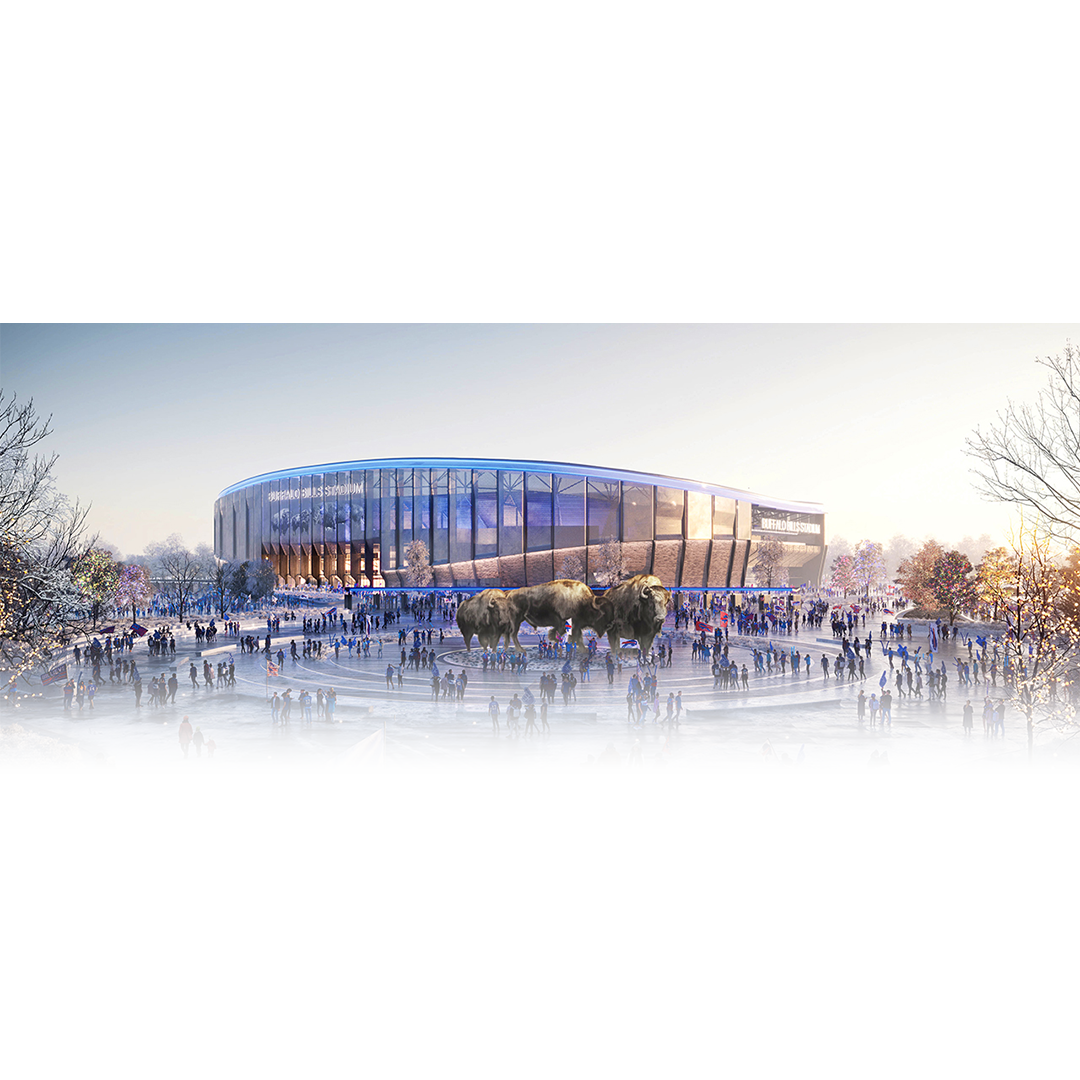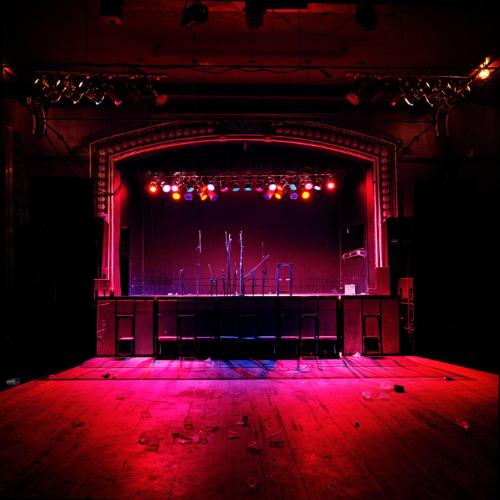
THE BUFFALO BILLS NEW STADIUM
HISTORY, DESIGN, AND EXPLORATION OF NFL STADIUMS
By: Sawyer Kron
NFL stadiums are a costly and controversial form of architecture. They can be incredibly expensive to build and destroy, with a heavy price tag landing on the taxpayer. However, it seems that as new stadiums continue to be built and funded as additions to the urban landscape, people are willing to pay and support these projects for the benefit of mass community building through entertainment.

The Bills, in conjunction with Legends and stadium architectural firm Populous, have left no stone unturned in covering every innovative element of new stadium design. The exterior stadium image highlights the team’s desire for a visual identity that reflects some of the historical architecture of Buffalo, while also delivering a modern appearance.
Buffalo Bills
Image on the left: 3d render of the new Buffalo Bills stadium
(Image source: Buffalo Bills)
Stadiums and sports teams are integral to creating an identity for a city, town, or state. They help to develop local and regional pride, and in doing so, publicly funded stadiums can continue to exist.
Stadiums can be publicly funded due to a loophole in the Tax Reform Act of 1986. The loophole works by creating a structure through tax-exempt municipal bonds. To gain access to the bonds, private companies must fail one of two tests inscribed in the bill. The second test states that no more than 10% of the bond’s debt service can be backed by the stadium itself. States and local governments willingly finance at least 90% of the stadium’s cost and in doing so allow the project to fail the second test and receive tax-exempt financing.
Tax Reform Act of 1986.
Click here for more information.
(Video source: CNBC)

The exploitation of people’s excitement for collective community, football, and leisure time creates a justification for taxpayers to support these projects. Once local support is gathered, a little bit of top-down pressure is applied through the sentiment, “if a city does not support the building of new facilities the league will threaten to move the team to another city.” This element of civic pride proves to be integral to pushing new stadium plans into law.
The Wellin, Hamilton College’s art museum, currently exhibits a photograph, St. Andrews Hall, Detroit, MI, October 28, 2008, taken by the artist Rhona Bitner. This image is part of a series that attempts to photograph every significant rock-and-roll venue in the United States. The image is of the empty stage and the standing area lit up by various red, blue, and purple lights. As written in the description to this piece: “Her lush, colorful photographs reflect the energy and layered history of spaces in their prime.” This image represents a community. The absent space conjures up thoughts of what it would be like to attend a concert there, and all you can think about is being surrounded by other like-minded people.
Image on the right: St. Andrews Hall, Detroit, MI, October 28, 2008, from the series “Listen”
(Image source: Wellin Museum)

This is what NFL stadiums seek to do. They create an atmosphere of fans who all have one goal in mind: to support their team.
In order to rally civic pride and team support the stadiums utilize architectural features. The architectural design of NFL stadiums creates an environment that perpetuates the support for the local franchise while simultaneously and purposefully dissuading people from engaging in political and economic policy surrounding professional sports. The Bills new stadium employs many design choices to do just this. Historic local Buffalo architecture was used as a heavy influence to the strength of the building and to create an intimate, football-first environment.
Image on the right: 3d render of the new Buffalo Bills stadium
(Image source: Buffalo Bills)


(Image source: Buffalo Bills)
The gargantuan, seemingly bronze-casted sculpture of three roaming buffalo that stands in front of the stadium exerts an overwhelming physical presence that instills pride. This symbolic presence speaks to the sentiment of a natural yet powerful connection to the buffalo, and in turn, a powerful connection to the team. Paired with modern-day technology like the new screens and neon lighting, the stadium deploys a barrage of purposeful design choices to reinforce team spirit.
All of these architectural and technological elements turn this stadium into a place of civic pride. Fans will remember the stadium and connect it with sentimentality about their first game with their friends and family. Civic pride and identity blind people towards the economic and political policy that goes into stadiums, and the NFL teams maximize this through purposeful architectural features.
Works Cited
- Baade, Robert A. “PROFESSIONAL SPORTS AND ECONOMIC IMPACT: THE VIEW OF THE UNITED STATES JUDICIARY.” Proceedings. Annual Conference on Taxation and Minutes of the Annual Meeting of the National Tax Association 90 (1997): 189–98. http://www.jstor.org/stable/41954532.
- Delaney, Kevin J., and Rick Eckstein. “Urban Power Structures and Publicly Financed Stadiums.” Sociological Forum 22, no. 3 (2007): 331–53. http://www.jstor.org/stable/20110215.
- Geeter, Darren. “Taxpayers Are Paying Billions for the Renovations and Construction of NFL Stadiums. Here’s How.” CNBC, December 22, 2022. https://www.cnbc.com/2022/12/22/taxpayers-are-paying-billions-for-nfl-stadiums-heres-how.html.
- Gumprecht, Blake. “STADIUM CULTURE: COLLEGE ATHLETICS AND THE MAKING OF PLACE IN THE AMERICAN COLLEGE TOWN.” Southeastern Geographer 43, no. 1 (2003): 28–53. http://www.jstor.org/stable/44371157.
- Horvatits, Chris. “Meet the Architects Designing the New Bills Stadium.” News 4 Buffalo, May 5, 2022. https://www.wivb.com/news/local-news/meet-the-architects-designing-the-new-bills-stadium/.
- Noll, Roger G., and Andrew Zimbalist. “Sports, Jobs, Taxes: Are New Stadiums Worth the Cost?” The Brookings Review 15, no. 3 (1997): 35–39. https://doi.org/10.2307/20080751.
- Populous. “Populous and Buffalo Bills Unveil New Stadium Design.” Populous, October 27, 2022. https://populous.com/populous-and-buffalo-bills-unveil-new-stadium-design.
- “St. Andrews Hall, Detroit, MI, October 28, 2008, from the Series ‘Listen.’” eMuseum. Accessed May 9, 2023. http://emuseum-2022.hamilton.edu/objects/6991/st-andrews-hall-detroit-mi-october-28-2008-from-the-se?ctx=f9919dd4786736ed94b2e309112e0b6a3331358f&idx=223.
- Swindell, David, and Mark S. Rosentraub. “Who Benefits from the Presence of Professional Sports Teams? The Implications for Public Funding of Stadiums and Arenas.” Public Administration Review 58, no. 1 (1998): 11–20. https://doi.org/10.2307/976884.
- “The Official Website of the Buffalo Bills.” Buffalo Bills Stadium News | Buffalo Bills. Accessed May 9, 2023. https://www.buffalobills.com/news/stadium-news.
- Veronica, Nick. “1 Year Later: New Bills Stadium Cost Rises $140m.” News 4 Buffalo, March 28, 2023. https://www.wivb.com/sports/buffalo-bills-stadium-discussions/1-year-since-agreement-bills-stadium-cost-has-risen-10/.
- YouTube. YouTube, 2023. https://www.youtube.com/watch?v=9OKqKOoPdk0.
- YouTube. YouTube, 2022. https://www.youtube.com/watch?v=QdwInehWPdU.
- YouTube. YouTube, 2022. https://www.youtube.com/watch?v=ECcfrlgwi0U.